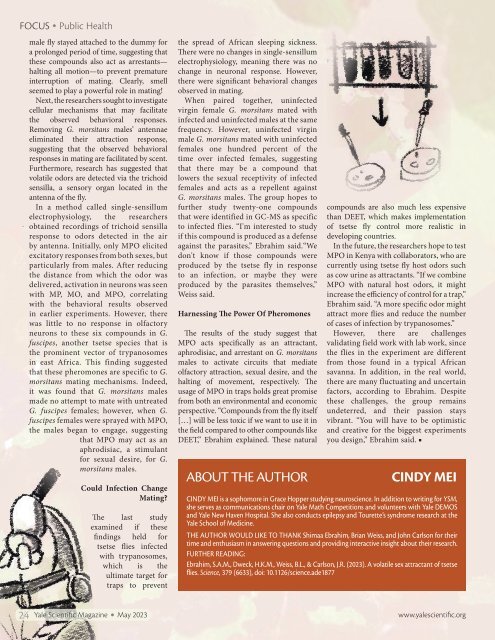YSM Issue 96.2
Create successful ePaper yourself
Turn your PDF publications into a flip-book with our unique Google optimized e-Paper software.
FOCUS<br />
Public Health<br />
male fly stayed attached to the dummy for<br />
a prolonged period of time, suggesting that<br />
these compounds also act as arrestants—<br />
halting all motion—to prevent premature<br />
interruption of mating. Clearly, smell<br />
seemed to play a powerful role in mating!<br />
Next, the researchers sought to investigate<br />
cellular mechanisms that may facilitate<br />
the observed behavioral responses.<br />
Removing G. morsitans males’ antennae<br />
eliminated their attraction response,<br />
suggesting that the observed behavioral<br />
responses in mating are facilitated by scent.<br />
Furthermore, research has suggested that<br />
volatile odors are detected via the trichoid<br />
sensilla, a sensory organ located in the<br />
antenna of the fly.<br />
In a method called single-sensillum<br />
electrophysiology, the researchers<br />
obtained recordings of trichoid sensilla<br />
response to odors detected in the air<br />
by antenna. Initially, only MPO elicited<br />
excitatory responses from both sexes, but<br />
particularly from males. After reducing<br />
the distance from which the odor was<br />
delivered, activation in neurons was seen<br />
with MP, MO, and MPO, correlating<br />
with the behavioral results observed<br />
in earlier experiments. However, there<br />
was little to no response in olfactory<br />
neurons to these six compounds in G.<br />
fuscipes, another tsetse species that is<br />
the prominent vector of trypanosomes<br />
in east Africa. This finding suggested<br />
that these pheromones are specific to G.<br />
morsitans mating mechanisms. Indeed,<br />
it was found that G. morsitans males<br />
made no attempt to mate with untreated<br />
G. fuscipes females; however, when G.<br />
fuscipes females were sprayed with MPO,<br />
the males began to engage, suggesting<br />
that MPO may act as an<br />
aphrodisiac, a stimulant<br />
for sexual desire, for G.<br />
morsitans males.<br />
Could Infection Change<br />
Mating?<br />
The last study<br />
examined if these<br />
findings held for<br />
tsetse flies infected<br />
with trypanosomes,<br />
which is the<br />
ultimate target for<br />
traps to prevent<br />
the spread of African sleeping sickness.<br />
There were no changes in single-sensillum<br />
electrophysiology, meaning there was no<br />
change in neuronal response. However,<br />
there were significant behavioral changes<br />
observed in mating.<br />
When paired together, uninfected<br />
virgin female G. morsitans mated with<br />
infected and uninfected males at the same<br />
frequency. However, uninfected virgin<br />
male G. morsitans mated with uninfected<br />
females one hundred percent of the<br />
time over infected females, suggesting<br />
that there may be a compound that<br />
lowers the sexual receptivity of infected<br />
females and acts as a repellent against<br />
G. morsitans males. The group hopes to<br />
further study twenty-one compounds<br />
that were identified in GC-MS as specific<br />
to infected flies. “I'm interested to study<br />
if this compound is produced as a defense<br />
against the parasites,” Ebrahim said.“We<br />
don't know if those compounds were<br />
produced by the tsetse fly in response<br />
to an infection, or maybe they were<br />
produced by the parasites themselves,”<br />
Weiss said.<br />
Harnessing The Power Of Pheromones<br />
The results of the study suggest that<br />
MPO acts specifically as an attractant,<br />
aphrodisiac, and arrestant on G. morsitans<br />
males to activate circuits that mediate<br />
olfactory attraction, sexual desire, and the<br />
halting of movement, respectively. The<br />
usage of MPO in traps holds great promise<br />
from both an environmental and economic<br />
perspective. “Compounds from the fly itself<br />
[…] will be less toxic if we want to use it in<br />
the field compared to other compounds like<br />
DEET,” Ebrahim explained. These natural<br />
ABOUT THE AUTHOR<br />
compounds are also much less expensive<br />
than DEET, which makes implementation<br />
of tsetse fly control more realistic in<br />
developing countries.<br />
In the future, the researchers hope to test<br />
MPO in Kenya with collaborators, who are<br />
currently using tsetse fly host odors such<br />
as cow urine as attractants. “If we combine<br />
MPO with natural host odors, it might<br />
increase the efficiency of control for a trap,”<br />
Ebrahim said. “A more specific odor might<br />
attract more flies and reduce the number<br />
of cases of infection by trypanosomes.”<br />
However, there are challenges<br />
validating field work with lab work, since<br />
the flies in the experiment are different<br />
from those found in a typical African<br />
savanna. In addition, in the real world,<br />
there are many fluctuating and uncertain<br />
factors, according to Ebrahim. Despite<br />
these challenges, the group remains<br />
undeterred, and their passion stays<br />
vibrant. “You will have to be optimistic<br />
and creative for the biggest experiments<br />
you design,” Ebrahim said. ■<br />
CINDY MEI<br />
CINDY MEI is a sophomore in Grace Hopper studying neuroscience. In addition to writing for <strong>YSM</strong>,<br />
she serves as communications chair on Yale Math Competitions and volunteers with Yale DEMOS<br />
and Yale New Haven Hospital. She also conducts epilepsy and Tourette’s syndrome research at the<br />
Yale School of Medicine.<br />
THE AUTHOR WOULD LIKE TO THANK Shimaa Ebrahim, Brian Weiss, and John Carlson for their<br />
time and enthusiasm in answering questions and providing interactive insight about their research.<br />
FURTHER READING:<br />
Ebrahim, S.A.M., Dweck, H.K.M., Weiss, B.L., & Carlson, J.R. (2023). A volatile sex attractant of tsetse<br />
flies. Science, 379 (6633), doi: 10.1126/science.ade1877<br />
24 Yale Scientific Magazine May 2023 www.yalescientific.org

















